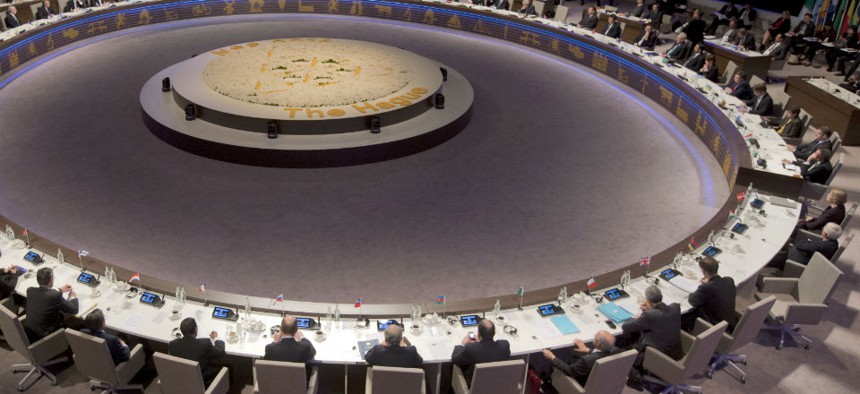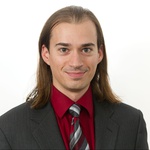Weapons-Grade Uranium Not a Must for Nuclear Medicine, Dutch Figure Says

The Nuclear Security Summit in The Hague, Netherlands Pablo Martinez Monsivais/AP
'It's not a matter of money,' Nederlof says. 'It's a matter of solving technical problems.'
A Dutch official says he is confident that the operators of a Netherlands reactor are doing all they can to meet a goal of producing radiological isotopes used in medical procedures without the use of bomb-grade uranium.
The Netherlands -- which hosted this year's Nuclear Security Summit -- agreed at the previous gathering of world leaders in 2012 to work toward a goal of producing medical isotopes without highly enriched uranium by 2015. The United States, France and Belgium also agreed to collaborate on the objective.
Under the deal, observers expected that Dutch producer Mallinkrodt would switch to using only low enriched uranium by 2015. Just weeks before this year's March summit, a U.S. watchdog group released information suggesting that the company was not expecting to meet that goal until at least 2017, however.
Included in the release was a letter that U.S. activists wrote to Dutch government officials urging them to persuade Mallinkrodt to accept U.S. financial and technical assistance in order to speed up the switch. Activists have contended that the company diverted resources away from the conversion project in order to address reactor shutdowns and maintenance issues, and that U.S. aid could help make up the difference.
During a recent interview, Kees Nederlof, who served as deputy to the Netherlands' lead summit organizer, downplayed the role such assistance could play in speeding up the process.
"It's not a matter of money," Nederlof told Global Security Newswire and Arms Control Today. "It's a matter of solving technical problems. Of course that needs and it requires money but it's not the most important thing. Suggestions that government aid would speed up this process, I think, are based on very little evidence."
Nederlof, who will take the lead role for the Dutch government in the run-up to the 2016 summit in the United States, said he was confident Mallinkrodt was doing all that it can.
"Reports that they were lazy in doing such are utterly nonsense, really," said Nederlof, who serves as an adviser for strategic affairs at the Dutch Foreign Ministry. "We have been closely involved in what they are doing, and we have been kept informed about all the stages of the conversions, and we are absolutely convinced that they are doing whatever they need to."
As for exactly when the conversion will be complete, Nederlof said he could not offer any promises. The goal is still 2015, he said, but he acknowledged it may take longer.
"That's for me very difficult to say," Nederlof said in the interview, which took place at the Dutch embassy in Washington last month. "We cannot exclude that the process will take until 2017. I have to take that into account. Who am I, from the government, to correct this estimate by a company?"
The Dutch official stressed that ensuring patients throughout the world have adequate supplies of medical isotopes is the priority.
"You're not going to jeopardize patients for a delay of one or two years," Nederlof said.
Edited excerpts of the interview, the second piece in a two-part series, appear below:
GSN: The latest we heard was that the Dutch reactor that produces medical isotopes would likely not stop using highly enriched uranium until at least 2017. Is that still the case or can that be sped up?
Nederlof: [At the 2012 Nuclear Security Summit] in Seoul, we stated that we will do our utmost … not only the Netherlands, but also Belgium and France, to have things converted in 2015. … It's still one and half years to go, but there are some technical obstacles, technical problems that they are now well on their way to resolving. Whether that will result in having conversion completed before the end of 2015 is a little bit too early to say.
Some people here in the U.S. … were jumping to conclusions. It's really too early to say, that's the first thing. The second is we've always maintained that the position of the patients all over the world who are dependent on these medical isotopes is an extremely important part of this. … You convert as much as possible but, if there are technical obstacles, you're not going to jeopardize patients. … That was always in the joint statement made in Seoul.
GSN: The company [Mallinkrodt] said that because of the obstacles, the switch might not be complete until 2017, but you think there is still a chance it could happen by 2015?
Nederlof: That's for me very difficult to say. … We cannot exclude that the process will take until 2017. I have to take that into account. Who am I, from the government, to correct this estimate by a company? … But once again, the position of patients worldwide is very central. You're not going to jeopardize patients for a delay of one or two years. …
In 2016, the Canadians will stop producing -- there will be a huge shortage. It would be very unpleasant for the world community if all of the sudden the supply of medical isotopes was stopped.
GSN: Do you have confidence that the company is doing all it can to make this happen as soon as possible?
Nederlof: Absolutely. Reports that they were lazy in doing such are utterly nonsense, really. We have been closely involved in what they are doing, and we have been kept informed about all the stages of the conversions, and we are absolutely convinced that they are doing whatever they need to. …
It's not a matter of money. It's a matter of solving technical problems. Of course that needs and it requires money but it's not the most important thing. Suggestions that government aid would speed up this process, I think, are based on very little evidence.
This article was published in Global Security Newswire, which is produced independently by National Journal Group under contract with the Nuclear Threat Initiative. NTI is a nonprofit, nonpartisan group working to reduce global threats from nuclear, biological, and chemical weapons.



